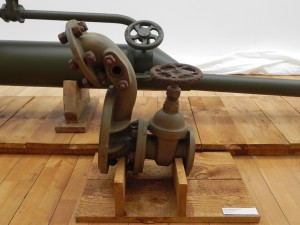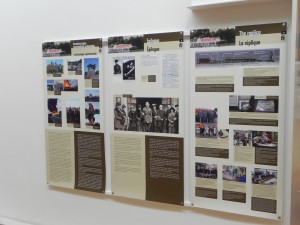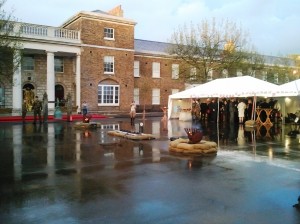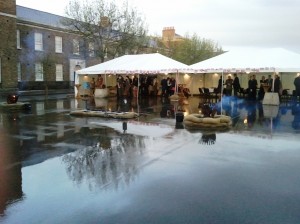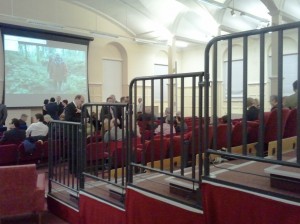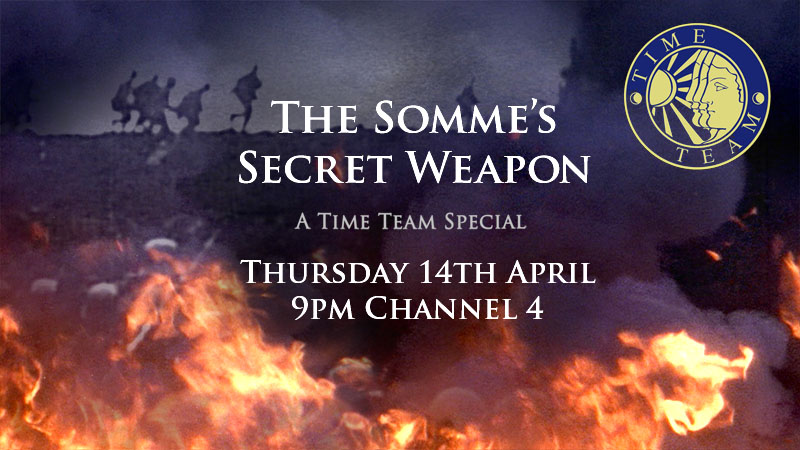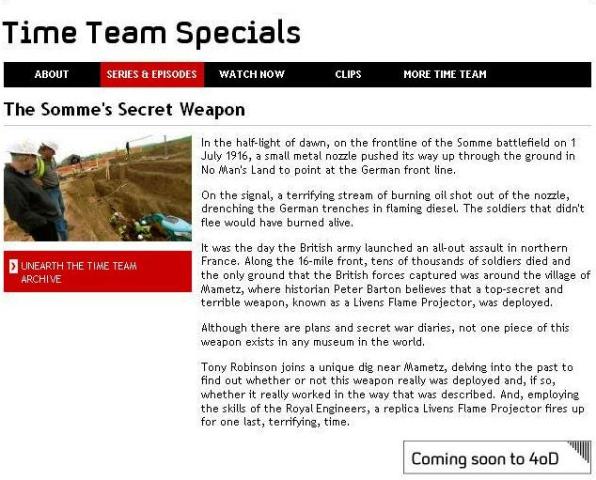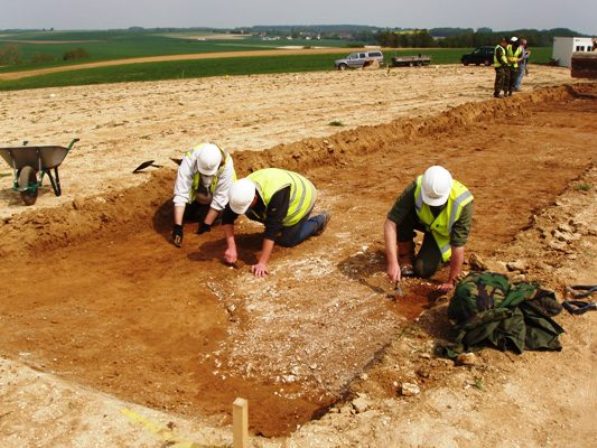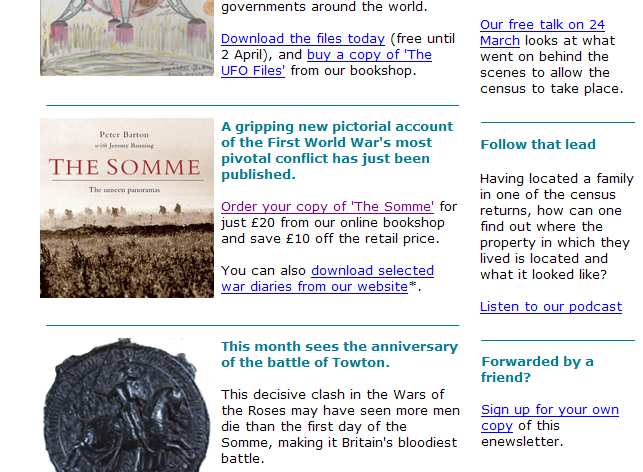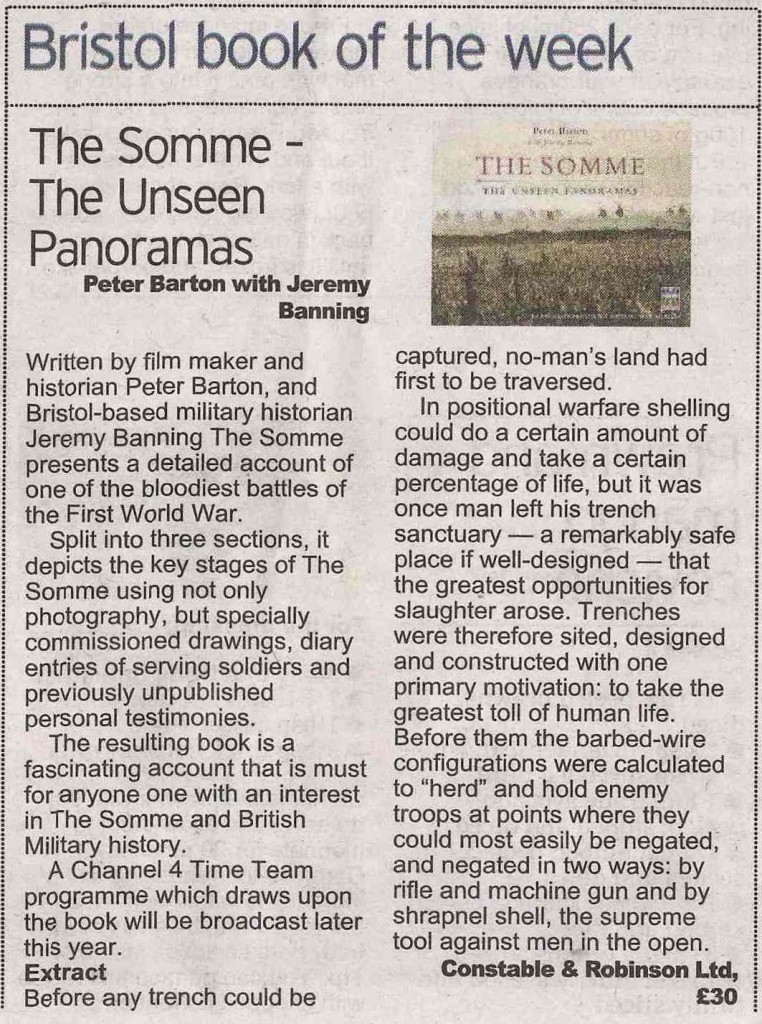Recent Posts
- Books for Sale
- A raid with severe repercussions: the mutilation of 8th Lincolns dead at Ghissignies, 2-3 November 1918
- New Battlefield Tour announced! Western Front Footsteps: Stories of courage and endeavour above and below the battlefield and the postwar reconstruction of French communities, 24-27 September 2021
- Filming with David Walliams for Who Do You Think You Are? and a look into his great-grandfather’s wartime service
- New Battlefield Tour announced! Western Front Footsteps: In the footsteps of ancestors, aftermath and memorialisation, 27 -30 September 2019
Testamonial
"Your gift is in putting your research in such a moving way that it comes alive, never to be forgotten"
- Grace AcottLatest Tweets
Posts Tagged ‘Peter Barton’
New BBC Two series: The Somme 1916 – From Both Sides of the Wire
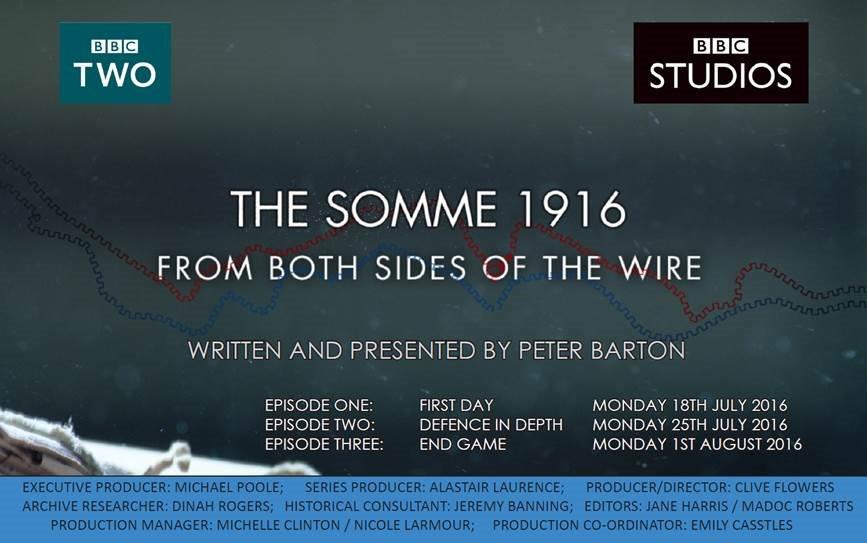
For the past 12-18 months I have been working as Historical Consultant on the three part BBC2 series, ‘The Somme 1916 – From Both Sides of the Wire’. Written and presented by my colleague Peter Barton, the series aims to show a previously neglected corroborative view of the battle, using material from the vast and mainly untapped German archives.
Programme website: http://www.bbc.co.uk/programmes/b07lst9b
The first programme is tonight at 9pm on BBC2 where to buy tramadol with the other two at the same time on 25 July and 1 August.
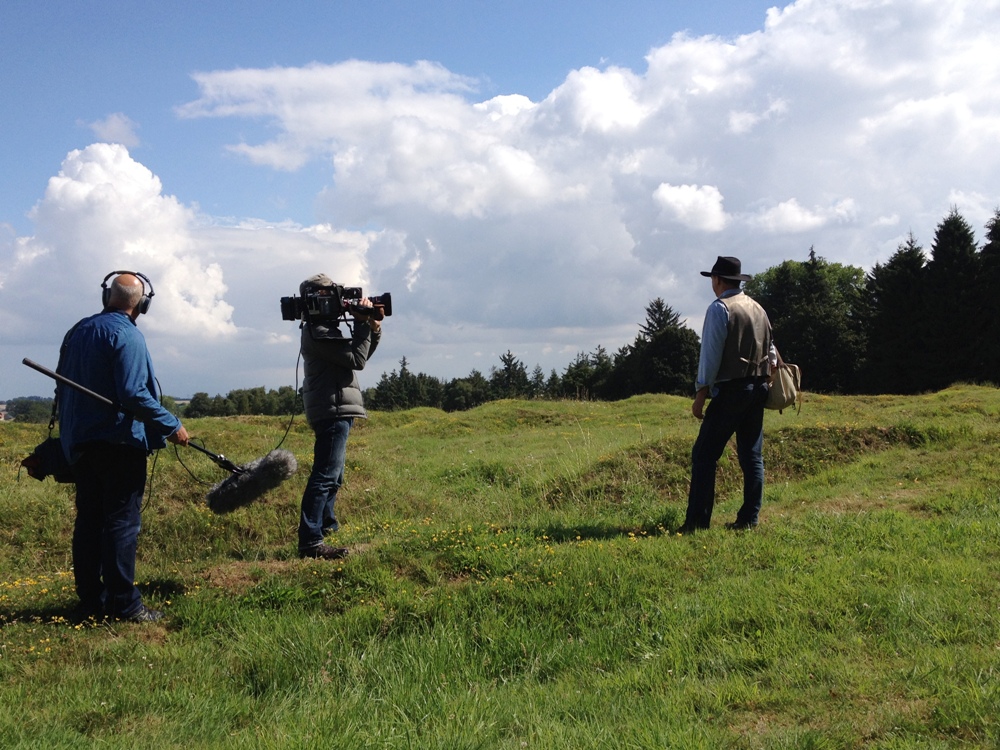
Peter Barton – filming at Newfoundland Memorial Park, Beaumont Hamel

Peter Barton – standing in the German lines in front of Montauban. Across these fields British soldiers and advanced and captured the village on 1 July 1916
“Breathing Fire” – Le Dragon de la Somme. Exhibition at the Historial, Peronne – opens tonight
Today sees the grand opening of the new exhibition about the Livens Large Gallery Flame Projector at the Historial in Péronne. I have taken a day out from a holiday and have just arrived in Péronne after three separate train journeys. The exhibition will commence with a few speeches and then the first screening of the “Breathing Fire – Le Dragon de la Somme” in French will be shown in two auditoriums. I understand from staff at the museum that usual attendances are about 80 people. That figure will be doubled tonight – we have 160 people coming along including many from the UK including representatives from the Corps of Royal Engineers.
I managed to get a few pictures earlier of the exhibition and, most notably, the specially-commissioned replica constructed by local students of vocational training centres. I will post an update later if time permits. Having worked on the project since its initial inception back in 2005/6 I am obviously a touch biased but, having had a good look at what has been produced and is on display, I can say that it looks fantastic and would urge any battlefield visitor to the Somme to take a look. The exhibition is currently scheduled to run to December 2011.
Further details can be found on the Historial’s website: http://en.historial.org/content/view/full/21046 and on my detailed blog post HERE.
EDIT: Evening went with a great success – speeches followed by the unveiling of the replica flame projector and then a viewing of the Breathing Fire film with French subtitles. A great evening and wonderful to see so many people from all around the western front – Johan Vandewalle from Polygon Wood, Alain Jacques from the Arras archaelogical service, Philippe Gorczynski, owner of D51 Deborah from Cambrai and Isabelle and Pascal from the Carriere Wellington, Arras to name a few. Thanks to all for their support.
Over the past few days Channel 4 have been showing trails for Thursday’s Time Team Special entitled ‘The Somme’s Secret Weapon’ and I have seen hits on the various articles on my website rocketing. I am heartened by the interest, and having seen the longer two-hour version of the film at a special event on Monday night at the Royal School of Military Engineering at Chatham I am confident that the visual impact of the film will attract plenty more interest. It is surely one of the most intriguing – indeed almost unbelievable – stories of the war. I have noted that many people are searching for the location of the dig site and I thought it appropriate that interested parties should be aware of the birth, the evolution and the structure of the project.
Initial stages
The idea of searching for the flamethrower was first mooted in 2005 when Peter Barton and I were working on our Somme panorama book. The book, now revised and back in the shops, covers the battle in its entirety but includes a lengthy section on the extraordinary story of the use, mis-use and lack of use of a considerable network on shallow tunnels dug under No Man’s Land by Royal Engineer Tunnellers in preparation for the opening of the battle. They were known as Russian Saps.
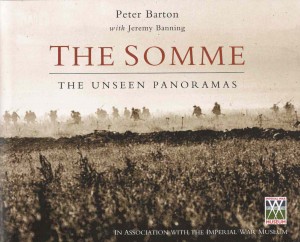
The Somme - the unseen panoramas by Peter Barton with Jeremy Banning. Published by Constable & Robinson.
In certain sectors on 1 July 1916 they were not used to their full potential whilst in the southern part of the British line the tunnels, terminating close to the German front line and integral dugouts, contained a variety of schemes to neutralise the enemy. These included substantial mines to destroy strongpoints, smaller bored charges to blow in dugouts, manholes close to the German trenches for the swift deployment of attacking forces into the line, trench mortar positions and machine gun emplacements emanating from tunnels in the middle of No Man’s Land, and perhaps most amazingly, huge flamethrowers for firing 100-metre jets of burning oil across and along German positions. The idea was to create a complex mixture of surprise and terror that would materially assist the British infantry to cross No Man’s Land and capture the enemy front line in a less molested manner than normal. It was the flame-throwers, however – the Livens Large Gallery Flame Projector – that seized the imagination, especially as they have received such scant attention in the mountain of literature associated with the Somme.
The projectors were almost 20 metres long, weighed 2.5 tonnes, and required a 7-man crew. Their placement in a tunnel beneath No Man’s Land was to attain an effective firing pattern some 50 or 60 metres from the German lines, and of course to keep their existence secret until the very moment of firing.

The Livens Large Gallery Flame Projector being tested at Wembley. Copyright National Archives. Reproduced with permission from NA file MUN5/385.
We knew that four had been planned for use on Z-Day. Two were deployed successfully from tunnels just to the west of the Carnoy-Montauban road whilst another was damaged and unused. The machine that really caught our attention was the one that was to have been fired from Sap 14 at a position in the British line between Bois Francais and Mansel Copse on the 7th Division frontage.
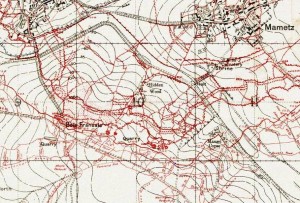
Trench map of the Fricourt - Mametz area dated June 1916. The tiny blue dot marks the site of the start of Sap 14 which was to house the flamethrower.
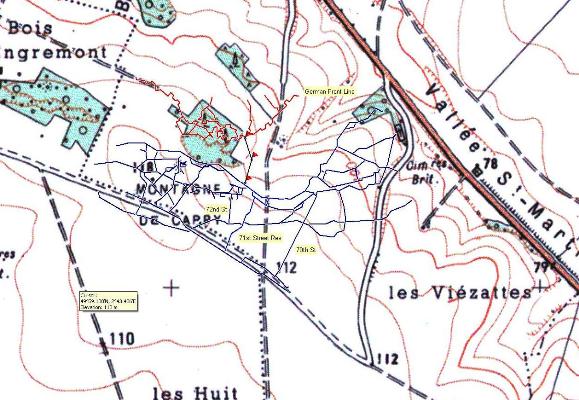
British (blue) and German (red) trench lines overlaid on a modern IGN map. The route of Sap 14 is marked by the red triangles. Courtesy of Iain McHenry using Linesman
The Special Brigade war diary showed that on 28 June the machine had been brought up to the front line along a communication trench called 71st Street by a party of around 250 R.E. and Devons (8th or 9th Battalion) but that heavy shelling of the area meant the parts had to be dropped whilst the men took cover. The most important parts were then picked up by the R.E. and placed in the entrance to Sap 14 for safety. However, this inclined entrance tunnel was then hit by a heavy shell which sealed up the end of the sap for 20 feet, ‘burying vital parts of the flammenwerfer beyond recall’. [Special Sections RE War Diary – ref: WO95/122]

Extract from War Diary of Special Section RE for June 1916. Copyright National Archives. Reproduced with permission from NA file WO95/122.
Preparation
It was this tenuous but enticing line in the war diary that was the catalyst for the project. Peter Barton’s knowledge of how the R.E. worked and the sequence of events subsequent to 1st July, combined with our archival research persuaded him that some of those parts would not have been recovered. His relationship with Canadian television producers Cream Productions was already established as a result of previous documentary work and Cream agreed to take on this ambitious and indeed risky project. Peter then spent weeks travelling between the UK and the Somme for myriad meetings for permissions and logistics – far too much to catalogue here but his workload was prodigious and the entire cheap tramadol online overnight project would not have been possible without this necessary but unglamorous work. On one of our first recces to the projector site we had a chance encounter with farmer Eric Delporte on whose land the old trenches and sap run through. After some initial scepticism he soon willingly gave use of his field free of charge, refusing any payment for ground rental or for lost crop yield on the basis that he owed it to the young British soldiers lying in the several nearby cemeteries. M. Delporte been the perfect host thereafter – a true gentleman and friend to us all.
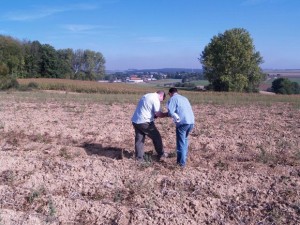
Using trench maps and Linesman on one of our recces to the site. The village of Mametz lies in the low ground at top of image
To cut a very long story short, by spring 2010 the dates for the dig had been fixed – it would be the final three weeks of May. The project brief was to study Sap 14 and the nearby trenches, enter and survey the saps if possible, and to locate and recover parts of the 1916 Flame Projector if still in situ.
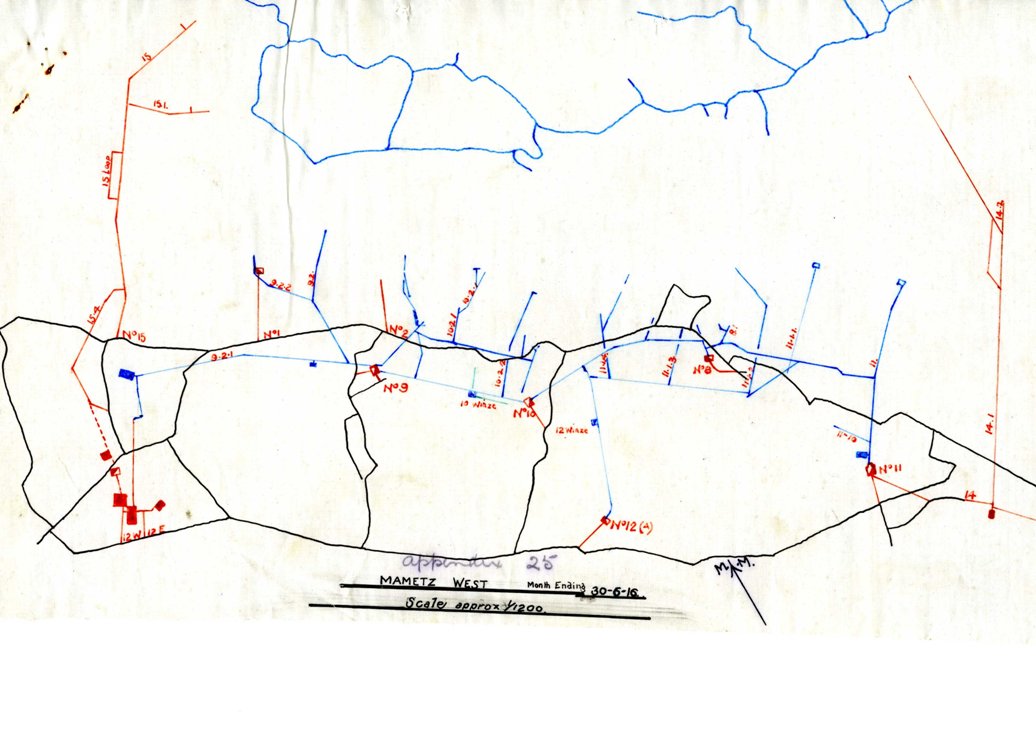
Map from war diary of 183 Tunnelling Company showing Mametz West secton. The flamethrower was to fire from the spur of Sap 14 on right of image. Image copyright National Archives. Reproduced with permission from NA file WO95/406.
The excavation was officially authorised by the French authorities and was under the archaeological control of Dr Tony Pollard and Dr Iain Banks of the Centre for Battlefield Archaeology, Glasgow University. We received enormous and invaluable assistance from the Historial de la Grande Guerre, the Préfecture de la Région Picardie, the Conseil Générale de la Somme, M. Stéphane Brunel and the Mairie of Mametz, Mines Rescue, Bactec International and the Corps of Royal Engineers. Most touching was the response of local businesses. As a result of visits by Peter with Francois Bergez (at present the acting Director of the Historial) they sponsored fencing, portakabins, water bowsers, digging machines, portable toilets, etc – all free of charge.
Archival research
I had carried out extensive archival work in the year before the dig, not only investigating as many files as possible with regard to the production, testing and deployment of the Livens Large Gallery Flame Projectors for the start of the Somme offensive but also the use of Russian Saps along the entire British battle front. Our colleague Simon Jones added further invaluable information to the database. I also looked into the subsequent use of the flame projector in September 1916 at High Wood and in front of Guillemont. The object of this intensive work was to gain a detailed understanding of the use of the machine but also to try and unravel how and why decisions were made on the use of the saps. I compiled a 65-page report including any mention of the potential use of flame projectors and saps from war diaries ranging from Army level down through Corps, Division, Brigade and Battalion and, of course the Tunnelling and Field Companies of the RE. Between Peter and I we spent months getting as well-versed in all matters subterranean as possible. Only by having this level of preparation did we feel prepared to start.
The dig – May 2010
The dig ran throughout May and was attended by hundreds of people – locals and battlefield visitors alike. The team adopted an ‘open house’ policy, and many people came to the site every day to watch our progress. On the second Saturday of the dig we had an official open day which was attended by several hundred people. Detailed presentations were given in French and English and we displayed many of the artefacts we had recovered. The results of the dig were spectacular and after three weeks solid work it was a tremendous feeling of privilege for us all to have worked on such a project and to have developed such close and ongoing links with many of the local people.
Finding out more
This post has been deliberately sparse with information on the dig itself for two reasons. Firstly, the international version of the film will not be aired until the autumn and therefore would not want to pre-empt this programme. Secondly, a huge amount of material will be on display in the forthcoming exhibition entitled ‘Breathing Fire – Le Dragon de la Somme’ to be held at the Historial at Peronne. This exhibition, curated by Peter, will incorporate a great deal of extra information, display the salvaged flamethrower parts, and (most surprising of all, perhaps) include a full-scale replica of the Livens machine. This is at present in the process of being built by metalwork students in Amiens. The exhibition will run from 16 June – 11 December 2011. An academic report on the Mametz dig by Tony Pollard and Iain Banks will be available in the next edition of the Journal of Conflict Archaeology.
How the Royal Engineers were persuaded to build and fire a working full-size modern version the flame projector is another story….but we thank and salute them.
Premiere of the ‘Breathing Fire’ documentary on the Livens Large Gallery Flame Projector at RE Barracks, Chatham
I attended the premiere of the Breathing Fire documentary on last May’s search for the Livens Large Gallery Flame Projector at Mametz (Somme) last night at the home of the Royal Engineers – Brompton Barracks in Chatham. Many of the team involved came from all over the country and it was good to meet up again with them and to catch up with the officers, NCOs and sappers who had been such an integral part of the dig.
The Corps had excelled themselves once again and three marquees had been erected to provide appropriate cover from the rather unwelcome showers that greeted us on arrival. These also housed the bar, tables and a good deal of information on the dig site including photographs and biographical details of Captain WH Livens and his various weapons of war. To add an authentic note to proceedings there were several serving soldiers kitted out in Great War period uniforms. The most impressive element was a small scale replica of the flame projector (approximately 12 ft long) which had been buy cheap tramadol in uk constructed in the square. Apparently it had been tested and could fire flame 30ft but this was (perhaps wisely) considered a bit of a risk with so many civilians around and so remained benign all night.
After canapés and bubbly we all made our way (via the red carpet) to the auditorium and after welcoming speeches we sat down to watch the long, international version of the ‘Breathing Fire’ film. A break was provided halfway through with time for ice-cream and then afterwards a curry supper was provided.
As the film highlights the skills of the Royal Engineers – in 1914-18 and nowadays too – it was well received by all. The evening was held in aid of the Army Benevolent Fund and was a resounding success with approximately 250 people attending. My thanks to all of those personnel who were part of the project and yesterday evening – it has been a remarkable experience to have been involved.
Update – 13 April 2011.
A detailed blog on the birth, evolution, research & structure of the Livens Flamethrower project with maps, plans and images can now be read here:
After much delay and waiting I am pleased to finally announce that the Channel 4 Time Team Special on our archaeological dig for the Livens Flame Projector dig at Mametz, Somme is to be aired at 9pm on Thursday 14 April. The working title was ‘Breathing Fire’ but C4 appear to have retitled it ‘The Somme’s Secret Weapon’. Details can be found via this weblink:
http://www.channel4.com/programmes/time-team-specials/episode-guide/series-6/episode-2
It has been edited down to fill a one hour slot (9pm – 10pm) – a mere 48 minutes of actual programme. I have watched the rough cut of the 83 minute version (for History Television and the international audience) and I thought it moved at great pace. It will be interesting to see quite how the editing team have managed to keep the story whilst cutting so much footage.
I am looking forward to seeing the long version of the film at the premiere to be held at the Brompton Barracks, Chatham on the 11th April and will write my thoughts next week after the event.
As ever, television can only give a tiny piece of the information gleaned in the research process. A detailed explanation of the use of the Livens Large Gallery Flame Projector can be found at the exhibition to be held at the Historial, Peronne from 16 June – 11 December 2011. Details can also be found in the revised 2011 edition of our Somme panorama book.
I subscribe to monthly emails from the National Archives with their latest news. Quite why, I don’t really know as I almost never read them but I am now glad that I did subscribe. For some reason I opened this month’s offering earlier today and was heartened to see that our new Somme panorama book was advertised. When I went on the website I discovered it was their ‘Book of the Month’!
Just a pity that despite the email using the new cover, the website below shows the old cover.
National Archives Bookshop ‘Book of the Month’
It would save much confusion if the new cover (with revised subtitle) was shown rather than that from the 2006 out of print version. Still, mustn’t complain as all publicity is good publicity….
I would welcome any other mentions of the book in any local newspapers, websites, bookshops etc.
N.B. Edit: 14 March – I was at Kew last week for a day’s research and spoke to the man in the bookshop, asking him who chose the ‘Book of the Month’. He replied that it was his choice and when I explained my involvement with the book we had a good chat. He was very complimentary about it and it was gratifying to hear his comments on content and quality.
Over the past few months I have been in touch with people at the Bristol Evening Post (whose stories also feature in the Western Daily Press and Bath Chronicle) after they ran the story about Alfred Flux’s graffiti in the Bouzincourt Caves on Armistice Day 2010. I had mentioned that the revised version of the Somme panorama volume was out in February and had arranged for a copy to be sent to them for review.
I have order tramadol visa just spent weekend away but was texted yesterday by a neighbour who congratulated me on the book being ‘Bristol Book of the Week’. Luckily she had saved me a copy of the review which is attached below. My thanks to Suzanne Savill for organsing this.
The revised and updated version of the 2006 Somme panorama book that I produced with Peter Barton is due out in the shops in February 2011. The official publication date is 24 February but I expect that copies will be available from the usual outlets a couple of weeks before then.
So, what is new?
The most obvious thing to note is that my name is on the cover this time and that the subtitle has changed from ‘a new panoramic perspective’ to ‘The unseen panoramas’. Other than that, text has been revised throughout and some pictures have been changed. There were elements of the 2006 version that we were not happy with and it is good that an opportunity has arisen to amend many of these parts. With every book you produce, there is inevitably a progression in the skills employed and understanding of what is required. I certainly found the Arras book easier to work on in the years 2008-10 than I did for the 2006 Somme version, but that is to be expected as in the intervening period we had produced the Passchendaele volume as well as my research on a couple of Richard van Emden’s books.
Some images have been replaced and, most notably, we have included a section of one of the most remarkable panoramas of the war – a German panorama taken on 18 August 1916 from a spot near Grevillers showing High Wood and Martinpuich under British bombardment. The undamaged tree-lined Albert-Bapaume runs right across the image. Many who have seen this panorama stand open mouthed – such is the effect of seeing what a Great War battlefield looked like.
Probably the most relevant inclusion to spring 2011 is the revision and addition to the section concerning the use of the Livens Large Gallery Flame Projector. We have added incredible pictures of the weapon in testing at Wembley and some shots from our successful archaeological dig at Mametz in May 2010 showing elements of what we found from the machine. I have seen the first rough cut of the ‘Breathing Fire’ TV documentary for worldwide distribution and it is looking very good. A version for a Channel 4 Time Team Special will be cut for the UK market and broadcast in the spring (exact date to be confirmed).
Should anyone have further questions about alterations to the book then please get in touch via the Contact page.
Now that I am back at my desk in Bristol I can reflect on a wonderful time spent in Arras from the 11-13 November with my colleague Peter Barton. The main reason for our visit was to do a talk (in French) to the locals and media. This was scheduled for 1830hrs on the 12th, ensuring we had sufficient time to meet up with Rachel Gray, great-niece of Percy Clare, 7th East Surrey Regiment. Those who have the Arras panorama volume will know his name – we used extracts from his fantastic memoirs extensively, both for the pre-battle build up and 9 April attack and the disastrous 3 May attack between the villages of Monchy-le-Preux and Pelves. Rachel lives in Aylesbury and her local paper, the Bucks Herald covered the story in a piece entitled “Following in the footsteps of a hero”.
I had let Rachel know about our talk some time ago and she had agreed to travel out to Arras with her partner Brian so that we could give her a highly personalised tour of the battlefields – literally, as the newspaper article intimated, following in Percy’s footsteps. After meeting at the Hotel d’Angelterre and having a quick fifteen minutes explanation of the battle we set off along the Arras-Cambrai road to the starting position of the 7th East Surreys on the first day of battle, 9 April 1917. Such is the quality and details of Percy’s writing that we could almost stand on the exact spot where each event happened. This luxury was denied us by the British front line, No Man’s Land and first four lines of German trenches being covered by the industrial units that have grown eastwards along the Roman road. Still, this did not spoil the experience.
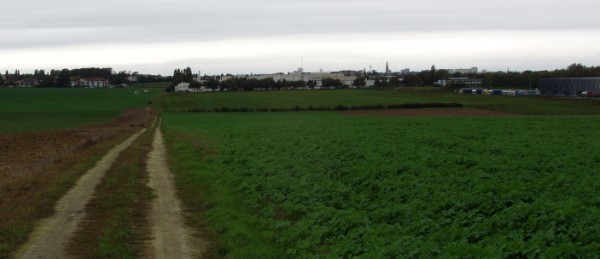
View from top of Observation Ridge looking back towards British lines and Arras - 7th East Surrey Regt fought their way up this slope on 9 April 1917
We then drove up over Observation Ridge and I pointed out the site of Sergeant Cator’s VC action and the site near Orange Hill where the battalion spent a freezing cold night on 11/12 April 1917. Percy Clare later wrote; ‘Of all the bad nights I spent in France, this one was easily the worst’. We then headed up to the fields between the villages of Monchy-le-Preux and Pelves where, by driving across the farm tracks (thank goodness for Peter’s Range Rover), we followed the disastrous attack of the battalion on 3 May 1917. It was possible to see the ‘dead ground’ which Percy described as sheltering him and his colleagues from German machine gun fire from the direction of Keeling Copse and Bois des Aubepines. We drove up a track to Bois des Aubepines to have a view of the entire battlefield and appreciate the commanding position the Germans held. As we looked back towards the British start positions in the direction of Bayonet Trench we knew that that this benign ground in front of us was the ground in which Percy Clare and his pal, Edward Gunnett had rolled back to safety whilst under continual German machine gun and rifle fire.

Standing at Bois des Aubepines - the fields in the background are those fought over on 3 May 1917 by Percy Clare and others of the 7th East Surrey Regiment
After spending some time here we went back into Arras and visited the Faubourg d’Amiens Cemetery and British Memorial to the Missing. The East Surrey’s panels bore names we recognised – one being Captain Thomas King, commanding ‘A’ Company whose compassion shone through when he had removed his coat, placing it over his sleeping servant in the bitter cold of the 11 April night. Captain King was then killed by a German grenade exploding on his chest in the 3 May attack. Another was Lance Corporal Christmas James Steele, a friend of Percy’s who had been killed when running into the British barrage on the German front line on 9 April and Private George Bean who Percy had discovered in No Man’s Land on 3 May, dead but with no trace of a wound on his body. We then headed back into Arras to drop Rachel and Brian off for a well-deserved lunch.

The name of Lance Corporal Christmas James Steele on the Arras Memorial to the Missing - one of over 35,000 names on this memorial alone
The Talk at the Wellington Quarry
Peter and I then spent a couple of hours putting up panoramas, aerials and maps on the walls in the Thompson’s Room at the Wellington Quarry – our talk venue. The talk began at 1830hrs and we were delighted with the number who came along on a wet, cold night – over 100 people meant standing room only at the back. Peter’s talk was entitled ‘The Battlefields of Arras – the Past, the Present and the Future’. It started with the Battle of Arras and focussed not on specific actions but more on general tactics as well as an emphasis on the importance of the quality of the battlefield archaeological work undertaken in Artois. I then spoke for about ten minutes (apparently my French was understood!) about Percy Clare and his role in the battle as an illustration of one man’s battle. My aim was to use his story to show the importance that the fields around Arras had for not only his family but thousands of others. Peter then talked about the mass grave excavations at Fromelles and our work near Mametz (Somme) in May this year on the search for remaining pieces of a Livens Large Gallery Flame Projector.
The talk was followed by a book signing and the event judged a great success. We were treated to a lovely meal out in a restaurant in the Petit Place by M. Prestaux, head of the Arras Tourist Board. My thanks to Isabelle Pilarowski and the staff at the Wellington Quarry, Alain Jacques and M. Prestaux. Lovely also to see Philippe Gorczynski there. Overall, it was a real success and an honour to find out that we were the first two English historians to speak in French to a French audience in Arras.
Wellington Quarry website is http://www.carriere-wellington.com/
A few lines to discuss the upcoming “The First World War From Above” to be broadcast on BBC One at 9pm on Sunday 7th November. I have seen some of the footage they are using – it was shot by the French from an airship which followed the destruction along the length of the western front – and it is absolutely spectacular. The programme promises to be fascinating. I know that both Peter Barton and Nigel Steel feature. I did a bit of research for them for the programme as well as getting maps/plans etc. of the tunnelling and underground systems at La Boisselle. I really am glad after the reduction in budgets over the years to see the BBC putting a big effort into First World War documentaries. BBC link can be found by clicking HERE and a blog on the making of the programme from Mark Radice, the Producer/Director is HERE.
Tonight’s 6 o’clock news contained this news piece with over two minutes of footage from Sunday’s programme: CLICK HERE FOR BBC NEWS PIECE



